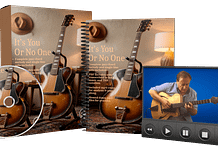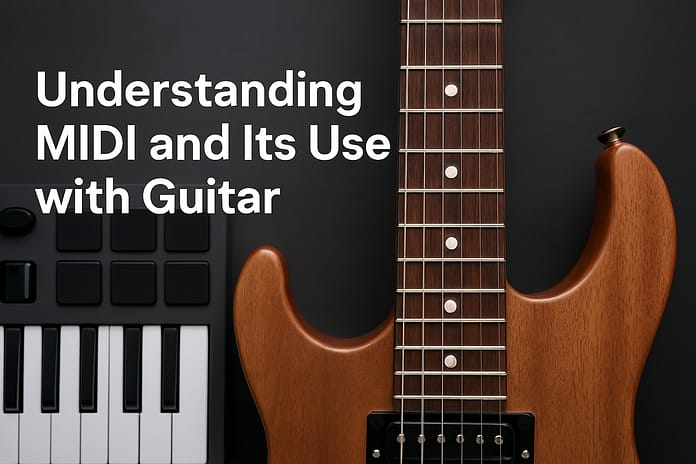This post may contain affiliate links. As an Amazon associate, Google associate as well as associate for other programs, Guitar & Music Institute may earn commissions from qualifying purchases.
MIDI and Its Applications for Guitarists: An In-Depth Guide
The Musical Instrument Digital Interface (MIDI) is a standardized protocol that enables seamless communication between electronic musical instruments, computers, and various audio devices. Originally developed for synthesizers and keyboards, MIDI has since expanded its role to become an essential tool for musicians across numerous genres. While the guitar is traditionally an analog instrument, integrating MIDI into a guitar rig opens up unprecedented creative possibilities, including advanced sound manipulation, automation, and digital synchronization. By embracing MIDI, guitarists can harness the same level of control and versatility that electronic musicians and producers have relied on for decades.
Understanding MIDI: The Fundamentals
MIDI differs from traditional analog audio transmission; rather than sending actual sound, it transmits performance-related data that dictates the parameters of musical output. This data-driven approach allows musicians to trigger virtual instruments, manipulate effects, and automate compositions with remarkable precision. Because MIDI does not carry audio, it remains highly flexible—allowing for seamless edits, transpositions, and modifications long after the original performance is recorded. Given its widespread adoption, MIDI has become a cornerstone of modern music production, live performance, and sound design.
MIDI messages typically include:
- Note On/Off: Triggers when a note is played and when it is released.
- Velocity: Determines the dynamic intensity of a note, influencing expressive nuances.
- Control Change (CC): Modifies parameters such as volume, modulation, filter cutoff, and effect settings.
- Program Change: Enables musicians to switch between different instrument patches or effect presets instantaneously.
- MIDI Clock: Synchronizes time-based effects, sequencers, and external devices to maintain tempo consistency.
With the advent of MIDI 2.0, the protocol has seen significant enhancements, including higher resolution, improved bidirectional communication, and increased expressivity. These advancements will further integrate MIDI into various musical workflows, providing an even more dynamic and responsive experience for guitarists.
MIDI and the Guitar: Expanding Creative Horizons
Although the guitar has historically been an analog instrument, MIDI integration has transformed the way guitarists interact with their gear and digital environments. Whether in live settings, studio production, or experimental sound design, MIDI enables guitarists to break free from the constraints of traditional pedalboards and amplifiers. The following are key ways in which guitarists can incorporate MIDI into their workflows:
1. MIDI Guitar Controllers
Modern MIDI guitars are built with hexaphonic pickups, which process each string’s signal independently. This allows for real-time MIDI conversion, enabling guitarists to control synthesizers, drum machines, and virtual instruments with precision. Additionally, onboard MIDI processors can convert analog signals into MIDI data, transforming a traditional guitar into a versatile digital controller.
Some guitars, such as the Jamstik Studio MIDI Guitar, feature dedicated MIDI hardware, offering plug-and-play functionality with DAWs and synthesizers. These instruments provide an alternative to keyboard-based MIDI controllers, allowing guitarists to compose and perform with familiar fingerings and techniques.
2. MIDI-Compatible Effects Pedals and Processors
Multi-effects units and rack-mounted processors often feature MIDI compatibility, allowing guitarists to automate preset changes, synchronize effects, and control multiple devices simultaneously. Line 6 Helix, Boss GT-1000, and Axe-Fx III are examples of professional-grade units that integrate MIDI extensively. With MIDI, a guitarist can instantly recall a complex effects chain, reducing reliance on manual pedal switching during live performances.
3. MIDI Pickups for Standard Guitars
For those looking to integrate MIDI into their existing guitar setup, MIDI pickups offer a non-invasive solution. These pickups convert string vibrations into MIDI data, enabling the triggering of synthesizers, sample libraries, and virtual instruments. Advanced systems such as the Roland GK-3 and Fishman TriplePlay provide accurate pitch tracking with minimal latency, making them ideal for both live and studio use.
MIDI pickups open the door to hybrid setups where guitarists can blend organic guitar tones with synthesized textures. This is particularly useful in progressive rock, electronic music, and film scoring, where complex soundscapes are often required.
4. MIDI in Studio Production
MIDI is indispensable in modern recording environments, allowing guitarists to manipulate performances with surgical precision. With MIDI recording, every note, velocity, and timing nuance can be adjusted post-performance, eliminating the need for re-recording. MIDI quantization and humanization tools ensure that performances remain rhythmically tight while retaining natural expressivity.
Guitarists can also use MIDI to program automation, dynamically controlling parameters such as wah filters, reverb levels, and delay times. Additionally, MIDI facilitates real-time pitch correction and harmonization, offering unprecedented creative control over guitar melodies.
5. Synchronization and Looping with MIDI
Live performers can benefit from MIDI’s ability to synchronize multiple devices, ensuring seamless timing across effects, loops, and backing tracks. Many loop stations and samplers, such as the Boss RC-600 and Electro-Harmonix 95000, accept MIDI input, allowing musicians to align loops perfectly with external sequencers or drum machines.
By integrating a MIDI foot controller, guitarists can navigate setlists, trigger samples, and adjust effects without taking their hands off the instrument. This level of control is especially advantageous for solo performers and looping artists who require hands-free operation.
Essential MIDI Equipment for Guitarists
For guitarists looking to incorporate MIDI, a variety of devices cater to different needs:
- Roland GK-3 MIDI Pickup: A hexaphonic pickup that provides accurate MIDI tracking for standard guitars.
- Fishman TriplePlay: A wireless MIDI guitar controller renowned for its precision and low latency.
- Boss SY-1000 Guitar Synthesizer: A powerful multi-effects unit that integrates MIDI for deep sound design capabilities.
- Line 6 Helix: A professional-grade effects processor featuring extensive MIDI control.
- Source Audio Soleman MIDI Foot Controller: A customizable footswitch for managing MIDI-enabled gear.
- Eventide H90 Harmonizer: An advanced effects processor offering MIDI-controlled harmonization and modulation.
- Fractal Audio Axe-Fx III: A flagship modeling unit with comprehensive MIDI automation capabilities.
- Boss ES-8 Effects Switching System: A loop switcher with MIDI support for controlling external pedals and rack units.
As the demand for MIDI integration continues to grow, new products emerge regularly, expanding the capabilities available to guitarists.
Conclusion: Redefining Guitar Performance Through MIDI
The integration of MIDI technology into guitar performance and production represents a paradigm shift in musical expression. No longer confined to traditional amplification and effects chains, guitarists can now manipulate digital soundscapes, automate complex setups, and expand their creative horizons in ways previously unimaginable. Whether crafting immersive live performances, composing intricate orchestrations, or experimenting with electronic textures, MIDI serves as a bridge between the analog and digital worlds.
As the industry advances, MIDI’s role in guitar playing will continue to grow, with innovations in tracking accuracy, wireless connectivity, and expressive control shaping the future of the instrument. For musicians willing to explore its possibilities, MIDI offers limitless opportunities for sonic experimentation and technical refinement.
For those new to MIDI, starting with a basic MIDI-enabled pedal or pickup can provide an accessible entry point. As comfort and familiarity increase, expanding to a full MIDI-controlled rig can unlock a world of creative potential. Regardless of skill level, embracing MIDI can elevate guitar performance, streamline production workflows, and redefine the boundaries of musical artistry.
This post may contain affiliate links. As an Amazon associate, Google associate as well as associate for other programs, Guitar & Music Institute may earn commissions from qualifying purchases.

























